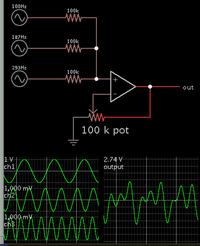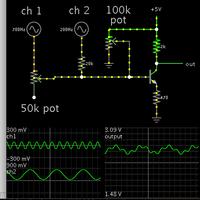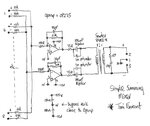benbiles
Member level 4

Hi,
I have a DAC wired up outputing 8 channels of differential audio ( balanced audio )
I would like to combine all the 8 channels into one differntial audio output introducing the least noise possible
and keeping the gain 1:1
I would have liked to do the mix in the DAC digatally but it seams that would need to be done in DSP or FPGA.
The volume contols are controlled via I2C from the microcontoller so I'm just looking to combine the differntial channels in the best way.
Would I use 2 op amps 1 non-inverting & 1 inverting in parralel ? if so is there a high quality dual op amp that would do the job well ?
Also does anyone know of an audio proccessor / dac / ??? IC that can digitally mix 8 or 16 tracks down to 2 channels ( stereo output ) whilst having unlimited mix routing control and or stereo balance control for each channel? I searched high and low but could only find TAS5558 that has mix routing but its outputs are PWM !!! and i'm not even sure if the mix routing allows combining of channels ( unclear in the datasheet )
If I can mix 8 - 1 in a clean way without loosing quality / dynamic range then I can use a second 8 channel dac for the 2nd channel output to form an 8 - 2 partly digital STEREO mixer
any ideas would be much welcome.. I will at some point order an FPGA board and try and learn DSP etc but for now I'm still trying to learn the basics !!
I have a DAC wired up outputing 8 channels of differential audio ( balanced audio )
I would like to combine all the 8 channels into one differntial audio output introducing the least noise possible
and keeping the gain 1:1
I would have liked to do the mix in the DAC digatally but it seams that would need to be done in DSP or FPGA.
The volume contols are controlled via I2C from the microcontoller so I'm just looking to combine the differntial channels in the best way.
Would I use 2 op amps 1 non-inverting & 1 inverting in parralel ? if so is there a high quality dual op amp that would do the job well ?
Also does anyone know of an audio proccessor / dac / ??? IC that can digitally mix 8 or 16 tracks down to 2 channels ( stereo output ) whilst having unlimited mix routing control and or stereo balance control for each channel? I searched high and low but could only find TAS5558 that has mix routing but its outputs are PWM !!! and i'm not even sure if the mix routing allows combining of channels ( unclear in the datasheet )
If I can mix 8 - 1 in a clean way without loosing quality / dynamic range then I can use a second 8 channel dac for the 2nd channel output to form an 8 - 2 partly digital STEREO mixer
any ideas would be much welcome.. I will at some point order an FPGA board and try and learn DSP etc but for now I'm still trying to learn the basics !!




